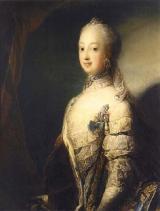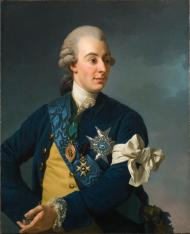Kdo se je poročil s Sophia Magdalena of Denmark?
Gustav III. poročen Sophia Magdalena of Denmark . Sofija Magdalena Danska je bila na poročni dan stara 20 let (20 leti, 4 mesecev in 1 dni). Gustav III. je bila na poročni dan stara 20 let (20 leti, 9 mesecev in 11 dni). Starostna razlika je bila 0 leti, 5 mesecev in 9 dni.
Sophia Magdalena of Denmark

Sophia Magdalena of Denmark (Danish: Sophie Magdalene; Swedish: Sofia Magdalena; 3 July 1746 – 21 August 1813) was Queen of Sweden from 1771 to 1792 as the wife of King Gustav III.
Born into the House of Oldenburg, the royal family of Denmark-Norway, Sophia Magdalena was the first daughter of King Frederick V of Denmark and Norway and his first consort, Princess Louise of Great Britain. Already at the age of five, she was betrothed to Gustav, the heir apparent to the throne of Sweden, as part of an attempt to improve the traditionally tense relationship between the two Scandinavian realms. She was subsequently brought up to be the Queen of Sweden, and they married in 1766. In 1771, Sophia's husband ascended to the throne and became King of Sweden, making Sophia Queen of Sweden. Their coronation was on 29 May 1772.
The politically arranged marriage was unsuccessful. The desired political consequences for the mutual relations between the two countries did not materialize, and on a personal level the union also proved to be unhappy. Sophia Magdalena was of a quiet and serious nature, and found it difficult to adjust to her husband's pleasure seeking court. She dutifully performed her ceremonial duties but did not care for social life and was most comfortable in quiet surroundings with a few friends. However, she was liked by many in the Caps party, believing she was a symbol of virtue and religion. The relationship between the spouses improved somewhat in the years from 1775 to 1783, but subsequently deteriorated again.
After her husband was assassinated in 1792, Sophia Magdalena withdrew from public life, and led a quiet life as dowager queen until her death in 1813.
Preberite več...
Gustav III.

Gustavo III de Suecia (Estocolmo, 24 de enero de 1746-Estocolmo, 29 de marzo de 1792) fue rey de Suecia desde el 12 de febrero de 1771 hasta su muerte. Era el hijo mayor del rey Adolfo Federico de Suecia y de la princesa Luisa Ulrica de Prusia. Era también primo de la emperatriz Catalina II de Rusia.
Gustavo terminó con la hegemonía de los partidos y con la llamada Edad de la Libertad en Suecia. A través de un golpe de Estado en 1772, llevó a cabo una reforma constitucional que lo encumbró en el poder absoluto. Intentó, sin éxito, una campaña de conquista que llevara al país a recuperar una posición importante a nivel internacional. Asimismo impulsó el florecimiento de la cultura nacional sueca, en el que participó activamente gracias a su amor al arte y a su amplia cultura.
Preberite več...